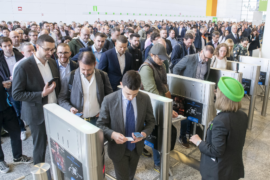Bellevue, Washington, USA-based Whooshh Innovations announced on May 20 that Austevoll Seafood ASA has agreed to purchase a 140-meter Whooshh fish transport system for its Atlantic salmon processing plant in Storebø, Norway, Austevoll Laksepakkeri AS. Scheduled to be installed soon by Stette AS, it will be twice the length of the Whooshh pilot system that went on line last year at the Vikenco AS plant in Aukra, Norway.
![]() According to Stette AS Managing Director Peder Stette, Austevoll plans to use the Whooshh system to move fish directly from the slaughter/gutting line to a filleting station by means of an above ground system that will transport (“whooshh”) the fish through the 140 meters in less than 30 seconds. The system will be suspended from the ceiling – four meters above the floor – saving valuable workspace at the facility.
According to Stette AS Managing Director Peder Stette, Austevoll plans to use the Whooshh system to move fish directly from the slaughter/gutting line to a filleting station by means of an above ground system that will transport (“whooshh”) the fish through the 140 meters in less than 30 seconds. The system will be suspended from the ceiling – four meters above the floor – saving valuable workspace at the facility.
Stette noted that, in addition to reducing the footprint of the processing plant, this configuration brings the added benefits of improving safety by decreasing forklift traffic in tight quarters and assuring the salmon reach their destination with minimum handling and within a closed system that assures hygienic conveyance.
Vincent Bryan III, chief executive officer of Whooshh Innovations, said the time is right for seafood producers to adopt smarter ways to cut costs and increase efficiencies by shifting away from labor-intensive steps that include loading salmon into totes, covering the product in ice, transporting with forklifts, and then unloading everything again.
The Austevoll Seafood Group is the major shareholder in both Lerøy Seafood Group ASA (LSG) and Br. Birkeland AS. With a total of 112 Salmon farming licenses in Norway, it ranks among the largest salmon producers in the world.
Through subsidiaries and associated companies, it is also a major player in the wild sector. The Group operates 28 fishing vessels from the North Atlantic to the South Pacific, with licensed quotas in three of the world’s most important fishery countries – Chile, Norway and Peru. Landings of pelagic species typically top 600,000 tons annually. Frozen products are caught, processed and destined for both domestic and international markets.





